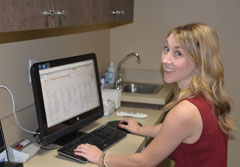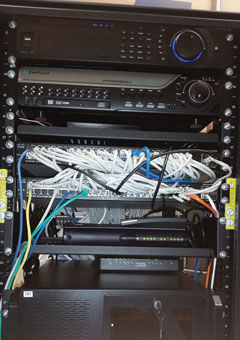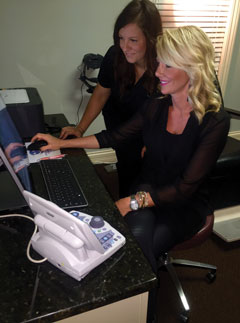If you’re still longing for the days when you could pick up a pen and write down your patient’s macular degeneration progress, or if you’ve warmed up to your software but aren’t quite thrilled, it’s time to face the facts: electronic health records (EHR) aren’t going anywhere.
With the federal push for Meaningful Use (MU) compliance and the recent conversion to ICD-10 codes, optometrists are becoming increasingly more reliant on their EHR systems. As such, seasoned users say buckle up for EHR’s long ride and don’t lag behind when it comes to your electronic record keeping.
“These systems have become very powerful. They’re not just EHR, they are the hub of your business,” says Jason Miller, OD, of Powell, Ohio.
This article features the wisdom of optometrists—who’ve been through EHR red tape, lawsuits and more—on how to troubleshoot software bumps and overcome frustrations so you can use this technology to its greatest benefit.
 |
| Kimberly Michel, OD, who practices at Eyelux Optometry, along with Brian Chou, OD, operates the team’s EHR. |
All EHR-induced Trauma
The biggest benefit of EHR for Brian Spittle, OD, of Midlothian, Va., is how it helps the doctors at his growing practice all get on the same page, especially since his practice recently expanded from two to four doctors. EHR provided him the efficiencies of continuity and consistency of documentation, he says. “We have a centralized data management system where all aspects of our practice come back to this one hub, and everyone is on the same talking points page,” says Dr. Spittle. While his practice has grown, so has his EHR system, which today has its own command central room, consisting of seven servers in a climate-controlled setting.
Of course, the seasoned pros remember the early growing pains of EHR. Brian Chou, OD, of San Diego, Calif., implemented his first system in 2006 and refers to the experience as “traumatic.”
“One doctor reverted back to paper, a staff member quit, patients were unhappy due to mistakes, it took longer for staff and doctors to figure out their usual functions and collections took a big, but temporary, hit,” he recalls.
When Dr. Chou moved to his current practice in 2011, the transition was a cinch since his new team was experienced with EHR, and there was good teamwork amongst the doctors and staff, he says.
EHR’s Bad Reputation
Scott Jens, OD, of Middleton, Wis., who is also the CEO of RevolutionEHR, estimates 75% of optometrists are using EHR today, and this percentage consists of early adapters who wanted to get rid of paper records, those who migrated to EHR because of MU and the latest recruits who got on board to help with conversion to ICD-10.
Whether its increased usage is out of necessity or choice, Dr. Jens says the main perceived obstacle of EHR is the belief that software has not automated practices as much as doctors had hoped.
“In some cases, people are saying, ‘I’ve never heard anyone say they are thrilled with their software,’”
Dr. Jens says. “I can tell you that’s not true, but that perception can be a big barrier to entry.” Another obstacle to EHR is that patients may pick up on their doctor’s unenthusiastic attitude, rather than embrace the education it enables, he adds.
Still, Dr. Jens believes those who’ve gotten on board with EHR know it is a very powerful tool for both the patient and the practice. For patients, it provides easily accessible information such as prescriptions, receipts and their personal health care records, in addition to the ability to schedule appointments through their personal portal, he says. And in turn, the software benefits the practice through gained efficiencies, including freeing up staff from running routine tasks such as recall reports for scheduling and appointment reminders that now are automated. These efficiencies reduce staff expenses and can refocus staff’s efforts on patient care. Additionally, the software ties the patient data to other health care providers, linking critical information such as medication history and previous diagnoses, he adds.
 |
| Brian Spittle, OD, opted to go with this server-based system rather than a cloud. His servers are housed in a climate controlled room. |
Surviving An MU Audit
In addition to choosing and implementing an EHR system, another big challenge is the fact that many are far behind in MU, Dr. Miller says. “CMS phased in various MU criteria along the way. It is going to take a high amount of commitment to meet each specific MU area,” he adds.
For those who’ve gone through MU audits, experts give one word of advice: documentation.
TeShawna Sutton, OD, of London, Ky., has survived not one, but two, attestation audits by the Centers for Medicare & Medicaid Services (CMS).
“The first audit was extremely scary,” she says. “Of course, that one was from our first reporting year and was, therefore, for the most money.”
But the initial audit helped her learn some valuable lessons moving forward, she says. “I hadn’t been quite as diligent with screenshots and creating a paper trail to prove that what I had reported was true up until that point,” she says. “That, of course, left a lot of questions open from the auditing firm; but luckily we were able to produce enough documentation to prove we had sufficiently met MU requirements.”
Since then, Dr. Sutton says her practice has been extremely diligent in its attestation process, including being vigilant on photo-documentation. Additionally, she hired an outside firm to do her security risk analysis (SRA) to ensure her practice has correctly prepared backup documentation.
Despite her efforts, her practice faced a round-two audit this year all because of a typo, she says. The second audit focused on an initial SRA that had the date of the previous year on the header. Fortunately, the company she hired had recorded and time-stamped phone calls and screenshots to prove the SRA had been completed in the correct reporting year. “It was a simple typographical error, but it carried big potential problems. Luckily, with experience, we have learned how to survive better,” she says.
While audits may be triggered by the way you bill a visit on a claim, many CMS audits are selected randomly, Dr. Jens says.
“Today, there isn’t a way to avoid an audit, but the way to succeed is to do MU by the book, and that means not taking shortcuts,” Dr. Jens says.
Staff: Train All or Select Few?
Most optometrists recommend you get your entire staff on board with EHR training. And most vendors will provide it, ranging from on-site—using a paid trainer, which is typically the most expensive—to do-it-yourself online videos and webinars, Dr. Chou says. “The training needs for each practice will vary from one to another. It requires careful and regimented planning to successfully pull off. It is definitely better to err on the side of overtraining than undertraining,” he says.
 |
| TeShawna Sutton, OD, gives staff member Sarah Lambdin some tips on using the EHR system. |
For Dr. Jens, training starts with the doctor. He says his EHR company has witnessed the best results when doctors agree to go through the training process with their staff. Given the widespread practice involvement of EHR—from the front desk to the back office, optical to contact lenses, and doctors to technicians—everyone needs to do their part when it comes to education, he adds.
At Dr. Spittle’s practice, every member of his staff is trained, but only in the precise aspects of their job that pertain to EHR. “The people who work in the exam rooms know a lot more about health records than the front desk,” he says. “Our system has been integrated to different parts of our day on the same system. We’re all integrated, but everyone knows what they should do (on EHR) to do their job.”
Working Out Workflow Kinks
Initially, implementing the new software will impact workflow and productivity, doctors say. As such, many doctors have opted to cut down the practice’s schedule during the initial roll out.
At Dr. Spittle’s practice, when he launched his second EHR system, he cut his patient volume in half for the first few days. “That’s one of those costs you don’t budget for ahead of time,” he says.
Adds Dr. Sutton, “I believe EHR has ultimately helped with workflow and productivity over the long term. It was cumbersome at first, as we were learning the program, but I believe now it’s a bonus. In the early days, we did some explaining to our patients that we were moving a little slower because of the computers, but I believe patients were seeing EHR being used all across health care, and they were accustomed to it.”
The Necessity of Specificity
With an updated EHR system, the recent conversion from ICD-9 to ICD-10 codes should not be an issue, Dr. Chou says. “With a decent EHR, coding is generally facilitated, since the EHR should auto suggest the appropriate code and allow the user to bring forth coding from prior exams,” Dr. Chou says.
For Dr. Sutton, coding has been the best thing about EHR. “Our software codes are based on what you build within the exam. The switch from ICD-9 to ICD-10 went much more smoothly than expected because of EHR,” she says.
Still, don’t get complacent about coding or what your EHR may be programmed to suggest as you document your patient’s visit. Otherwise, it could cost you.
With some new ICD-10 codes coming out this year, it is important for doctors to stay abreast of them, Dr. Jens says. While CMS and private payers were more lenient this year with ICD-10 codes, more specific eye codes, especially ones for chronic eye diseases, are on deck, and Dr. Jens cautions doctors to be as specific as possible with coding, or they will likely start to see claims rejected in 2017.
“I urge doctors to say, ‘Okay, I made the conversion, but now I might have to update my codes once again to get to the most specific version,’” Dr. Jens says.
Since Dr. Jens recently served as an expert witness on an EHR malpractice case, he stresses doctors should be as specific as possible when it comes to coding and documenting patient visits.
“The paradox with EHR is that the recordings are highly legible but sometimes inaccurate.” Dr. Chou says. “This is because EHR makes it so easy to create ‘normal’ findings to meet various exam criteria. But if the findings aren’t actually normal, then it’s data fabrication.”
He gives the example of EHR that automatically copies the entry of eye pressure for the right eye to the left eye. “Presumably, the software engineers thought they were helping practitioners save time,” Dr. Chou says. “But in doing so, this can create false data. In this previous example, if the IOP of the left eye is not taken, the EHR user must delete the copied IOP reading in the field for the left eye, or else it appears as if the eye pressure in the left eye was actually taken, even if it wasn’t.”
Dr. Chou, who has recently served as an expert witness in several medical malpractice cases where EHR was used, has seen how this type of error has caused major problems. In these lawsuits, there was conflicting information because normal data was automatically populated and the prior exam information was copied forward because, essentially, it was an easy shortcut, althought innacurate.
There are other situations where properly documenting a finding, such as screening for a visual field defect, is so cumbersome and time consuming, that the practitioner is tempted to just record a normal finding,
Dr. Chou adds. “A well-designed EHR uses practitioner feedback to guide development of their software so that these sorts of burdens are minimized without compromising the accuracy of documentation.”
“It’s not difficult to use EHR to make your records look incredibly strong if you just use them to their fullest and not take shortcuts,” Dr. Jens adds. “I compel optometrists to look at medical records as their way of staying actively involved in the future of medical care. But in the end, it’s about making sure a patient’s wellness is well tracked,” Dr. Jens says.
Software in the practice is really meant to improve patient care and outcomes, and with that comes an expectation to diligently document a medical service as specifically as possible, Dr. Jens says. “I fear that without the panacea for data input, many doctors won’t appreciate the value of documenting everything to the most granular degree. I trust this industry to make advances to make data entry easier and easier over time, and that doctors of optometry remember that it’s not just about good outcomes management, but that the medical record in an EHR is still the determinant in medicolegal situations. It’s not the testimony on the stand that matters. It’s what the record says.”
EHR for many might not be perfect, but it has become an ally to most practices. “I may have said at one time that I’d love to see us go back to when we didn’t have computerized records,” Dr. Sutton says. “But now, I would definitely say there’s no way I would want to go back to paper at this point.”
